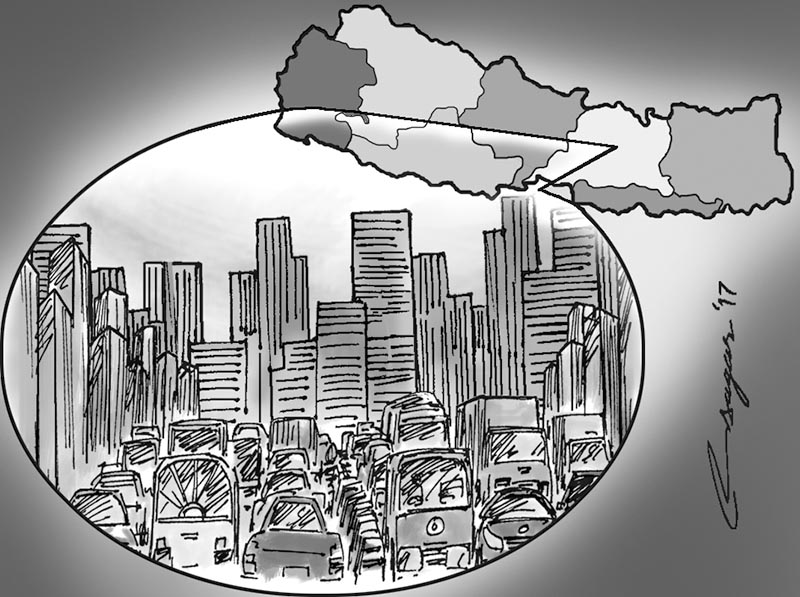Save Kathmandu: Time to invest in other cities
Focus must shift to improving the facilities that already exist. Kathmandu is already a major tourist destination; it is high time its cultural, religious and archaeological values were preserved well to make it even more beautiful
Our Capital city is becoming overcrowded by the day. While the population is reaching the Valley’s brim, dirt and dust have overpowered the three cities are renowned for their cultural and heritage values. Kathmandu, Patan and Bhaktapur—the three cities of the Valley which are known as cities of temples—now are on the verge of losing their charm, thanks to mismanagement and failure on the part of all concerned to pay due attention.
Tall buildings all across the cities have swallowed the ancient structures with architectural and archaeological significance. What is most worrisome is the Valley has greatly lost open spaces, a grim fact that was realised the most when the devastating earthquake hit the country, including Kathmandu, Bhaktapur and Patan. Roads have become narrower and rise in the number of vehicles day by day is making them even more congested. Traffic congestions, bad public transport facilities, absence of open spaces and greenery, haphazardly built concrete buildings--all are ruining the beauty of the Valley cities.
Until 2001, Kathmandu, Patan, Bhaktapur, Thimi and Kirtipur had a population of around 1.5. But with the urban agglomeration across the Valley, which includes 11 cities of Kathmandu, four of Bhaktapur and three of Lalitpur, the population has reached about 4.5 million. While the nationwide decennial population growth rate is 1.35 percent, it is more than three times percent in the Valley.
Spread over 754 square kilometres, it is now one of the most dense and crowded capital cities of the world. In population density, we are equal to Bangkok and more crowded than London, Buenos Aires or Barcelona. But the planned infrastructures and management make
other capital cities more comfortable and healthy than Kathmandu.
Now, for most people who are living here, the city has become a compulsion rather than convenience.
With all types of pollution—air, water, land and noise—that is well above the permissible limits, city dwellers are exposed to health risks. According to the Pollution Index 2017 published by Numbeo.com, Kathmandu is the fifth most polluted capital city in the world.
City air is eight times more polluted on weekdays than the allowed World Health Organisation levels. According to doctors at Bir Hospital, death caused by air pollution has increased 25 percent more in 2016 than in 2015.
Drinking water is scarce in the city so almost all household have to rely on unreliable drinking w ater from private suppliers. In different studies, the presence of E coli and coliform bacteria in Valley water was found at an alarming rate at various places. They have found bacterial contamination in the drinking water at a level 10 to 15 times higher than the allowed level. In 2016 there was an outbreak of cholera, with 130 reported cases at the Sukraraj Tropical and Infectious Disease Hospital of Kathmandu. Out of these 130 cholera-infected people, 101 were from Lalitpur and the remaining from Kathmandu. This dream city has crossed its threshold. Unbearable population density is responsible for most of the problems.
The Valley cities have not been able to cope with rising population, as they have not been upgraded as per the need. On the other hand, decentralisation process yet to work properly, people from across the country have been left with no option than to migrate to the Capital, for it has good schools and colleges and better health facilities among others.
For most of the government-related works also people have to visit the Capital. All centrally administered offices and ministries are also here.
With recent elections, which have installed local governments at the grassroots and will install provincial governments in all seven provinces, there is hope that decentralisation process will soon be expedited. But as far as the Valley is concerned, there is an urgent need to check its expansion. New infrastructure in urban centres must not be allowed any more, while city councils must work to provide better services to people. Basic facilities like drinking water, public transport, drainage system and waste management must be upgraded.
Focus must shift to improving the facilities that already exist. Kathmandu is already a major tourist destination; it is high time its cultural, religious and archaeological values are preserved well to make it even more beautiful. The rate at which the Capital is bearing the brunt of overcrowding, dirt and pollution, the city may soon get exhausted. Seven new provinces have been carved out under the new constitution adopted in 2015.
While developing Kathmandu and other cities of the Valley and preserving their ancient values, it is time authorities charted out plans to build at least one well-managed city in each province. All provinces should be developed with good schools, colleges and health facilities. This will not only help Kathmandu maintain its charm but also will take a lot of burden from it. While working on the new cities in the provinces, city planners must take into account the pressure Kathmandu and other Valley cities have gone through. Investing in well-planned cities across the country will ultimately pay off in a long term, which will ultimately help in overall development of the country.
Satyal holds a PhD from University of Vienna






